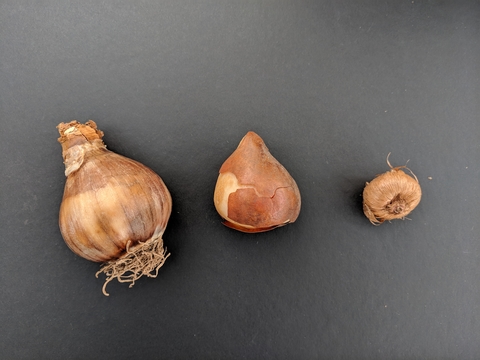I love living in a northern climate. For several years, I lived in South Carolina where I was considered by many of my Carolinian friends to be crazy, since every winter I wished for snow. Now that I’m back in snow country, come March, I find myself desperately searching for signs of spring. Finding a crocus bloom peeking out through the snow generally does the trick!

Spring flowering plants such as daffodils, hyacinths, and tulips are commonly referred to as hardy bulbs. They require a cold period to break dormancy and start their spring flower development. These spring bloomers are planted in the fall so our winter can provide the prerequisite cold. Hardy bulbs require little care once properly planted and offer an explosion of color at a time of year we can really appreciate it. By planting a variety of bulbs, you can enjoy blooms from March to June for years to come.
Select bulbs that are large and firm. If not planted right away, store in a cool, dry area away from direct sunlight. Full sun is recommended for most spring blooming bulbs, but some varieties do fine in partial shade. Well-drained soil is essential for hardy bulbs so avoid planting near down spouts and sprinkler systems.
Before planting, it is always a good idea to amend the soil with organic matter such as compost. This will also help with drainage. It is not necessary to fertilize when planting bulbs. Wait until spring and fertilize lightly as the flowers begin to die. Select a fertilizer labeled for bulbs and follow the product instructions for how much to apply. Water the fertilizer in well.
Planting bulbs at the correct depth is also important. If your bulb package doesn’t include planting depths, the rule of thumb advises planting bulbs 2-3 times as deep as they are wide. Plant the bulb tip up. If the top and bottom of the bulb are not obvious, plant the bulb on its side. Once planted, thoroughly water the area to get the bulbs started on their rooting process.
After the ground freezes, remember to cover your bulb bed with 2 to 3 inches of mulch. Use lightweight mulch such as chopped leaves.
Come spring, deadhead the spent blooms, which will help keep your bulb garden looking fresh and tidy. After the bulbs are done blooming, leave the foliage until it turns yellow. The green leaves produce sugars that are stored in the bulb to use next spring.

Common reasons bulbs may fail to flower include being planted too shallow or too late in the season. Bulb rot can occur if bulbs get too much water. Poor quality bulbs could also be the culprit. If bulbs flower the first year but not the second, the area may be too shady, and the plant was unable to produce enough food to store for the next year’s flower.
October may not seem like a month to get planting, after all, most of us are still busy putting our gardens to bed for the winter. But now is the time to plant those spring flowering bulbs – trust me, the reward of seeing their early spring color makes it worth the effort. And don’t forget, now is the time to plant garlic too.
For more information on planting hardy bulbs, see the University of Minnesota Extension publication, “Planting bulbs, tubers and rhizomes” at https://extension.umn.edu/how/planting-bulbs-tubers-and-rhizomes. For more information on planting garlic, take a look the UW Madison Extension article, “Garlic, Allium sativum” at https://hort.extension.wisc.edu/articles/garlic-allium-sativum/.




